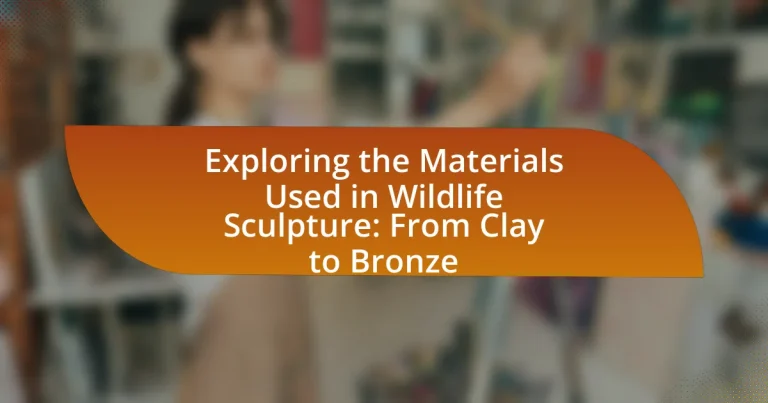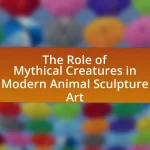The article “Exploring the Materials Used in Wildlife Sculpture: From Clay to Bronze” examines the primary materials utilized in wildlife sculpture, including clay, wood, stone, metal, and resin. It details the unique properties of each material, such as clay’s malleability for intricate modeling, wood’s natural aesthetic, stone’s durability, and bronze’s strength for casting. The article also discusses how sculptors choose materials based on factors like durability, aesthetic qualities, and intended display environments, while highlighting emerging trends in sustainable materials and innovative techniques in contemporary wildlife sculpture. Additionally, it provides insights into how personal style and technique influence material selection, offering practical tips for aspiring sculptors.
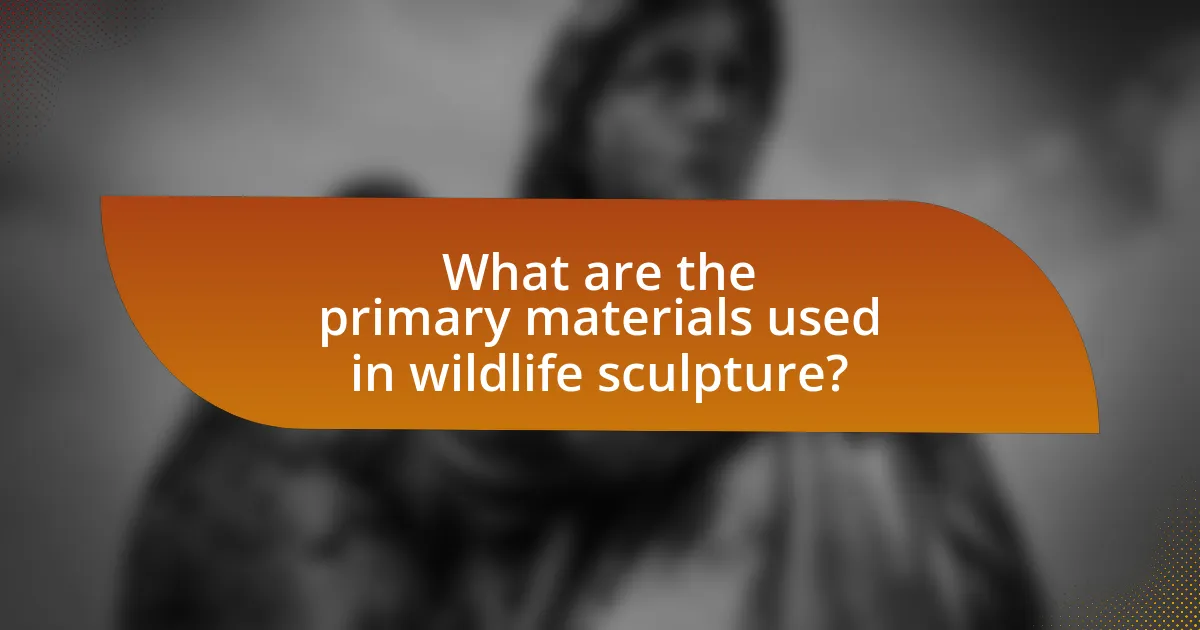
What are the primary materials used in wildlife sculpture?
The primary materials used in wildlife sculpture include clay, wood, stone, metal, and resin. Clay is often utilized for its malleability, allowing for detailed modeling, while wood provides a natural aesthetic and can be carved into intricate designs. Stone, such as marble or granite, offers durability and a timeless quality, making it a favored choice for many sculptors. Metal, particularly bronze, is widely used for casting due to its strength and ability to capture fine details. Lastly, resin is popular for its versatility and ease of use in creating detailed replicas. These materials are chosen based on their unique properties, which enhance the artistic expression and durability of the sculptures.
How does clay serve as a foundational material in wildlife sculpture?
Clay serves as a foundational material in wildlife sculpture due to its malleability and ability to capture intricate details. This versatility allows sculptors to create lifelike representations of animals, as clay can be easily shaped and refined to depict textures such as fur and feathers. Additionally, clay’s plasticity enables artists to work on a sculpture over time, making adjustments and enhancements as needed. Historical evidence shows that many renowned wildlife sculptors, such as Sir Edwin Landseer, utilized clay in their initial modeling processes before casting in more permanent materials like bronze, demonstrating its critical role in the sculpting workflow.
What types of clay are commonly used by sculptors?
Sculptors commonly use several types of clay, including earthenware, stoneware, and porcelain. Earthenware is favored for its workability and low firing temperature, making it ideal for beginners and detailed work. Stoneware, known for its durability and higher firing temperature, is often used for functional and artistic pieces. Porcelain, while more challenging to work with due to its fine texture and high firing temperature, is prized for its strength and translucence in finished sculptures. These clays are selected based on their specific properties that suit various sculpting techniques and desired outcomes.
How does the texture of clay influence the final sculpture?
The texture of clay significantly influences the final sculpture by affecting its surface appearance, detail retention, and overall tactile quality. Different textures, such as smooth, coarse, or porous, can enhance or diminish the visual impact of the sculpture. For instance, a smooth texture allows for fine details and a polished finish, which can create a more realistic representation of wildlife. Conversely, a coarse texture may add a rugged, organic feel, emphasizing the natural aspects of the subject. Research indicates that the manipulation of clay’s texture can also impact the drying and firing processes, which are crucial for the durability and integrity of the final piece. Therefore, the choice of clay texture is essential in achieving the desired aesthetic and structural qualities in wildlife sculptures.
What role does wood play in wildlife sculpture?
Wood serves as a fundamental medium in wildlife sculpture, providing both aesthetic appeal and structural integrity. Artists utilize various types of wood, such as mahogany and oak, for their durability and natural beauty, allowing for intricate detailing that captures the essence of wildlife. The grain patterns and textures inherent in wood enhance the visual representation of animals, making sculptures more lifelike. Additionally, wood is relatively easy to carve, enabling artists to achieve fine details and smooth finishes, which are essential for realistic portrayals. Historical practices show that wood has been a favored material for centuries, with notable examples found in indigenous art forms, underscoring its longstanding significance in the field of sculpture.
What types of wood are preferred for carving wildlife sculptures?
Basswood, butternut, and cherry are preferred types of wood for carving wildlife sculptures. Basswood is favored for its softness and fine grain, making it easy to carve and ideal for intricate details. Butternut offers a warm color and is also relatively soft, allowing for smooth carving. Cherry, while harder than the previous two, is appreciated for its rich color and durability, providing a beautiful finish that enhances the sculpture’s aesthetic. These woods are commonly chosen by sculptors for their workability and visual appeal, making them suitable for detailed wildlife representations.
How does the grain of wood affect the artistic outcome?
The grain of wood significantly influences the artistic outcome by affecting texture, visual appeal, and the overall character of the sculpture. Different wood grains, such as straight, wavy, or interlocked, create varying surface patterns that can enhance or detract from the intended artistic expression. For instance, fine-grained woods like maple allow for detailed carving and a smooth finish, while coarse-grained woods like oak provide a more rustic appearance that can add depth and interest to the piece. The choice of wood grain directly impacts how light interacts with the surface, influencing the sculpture’s aesthetic qualities and emotional resonance.
Why is bronze a popular choice for wildlife sculptures?
Bronze is a popular choice for wildlife sculptures due to its durability and ability to capture fine details. This metal alloy, primarily composed of copper and tin, withstands various environmental conditions, making it suitable for both indoor and outdoor displays. Additionally, bronze can be cast with high precision, allowing artists to create intricate textures and lifelike representations of animals. Historical evidence shows that bronze has been used for sculptures since ancient civilizations, further validating its longstanding reputation as a preferred medium in the art world.
What are the advantages of using bronze over other materials?
Bronze offers several advantages over other materials, particularly in the context of wildlife sculpture. Its durability ensures that sculptures can withstand environmental elements without significant degradation, making it suitable for both indoor and outdoor displays. Additionally, bronze has excellent casting properties, allowing for intricate details and fine textures that enhance the artistic representation of wildlife. The alloy’s resistance to corrosion, especially in outdoor settings, further extends the lifespan of sculptures compared to materials like iron or untreated wood. Historical evidence shows that bronze sculptures from ancient civilizations have survived for centuries, demonstrating its long-lasting nature and aesthetic appeal.
How is the bronze casting process executed in wildlife sculpture?
The bronze casting process in wildlife sculpture is executed through a series of precise steps, beginning with the creation of a model, typically made from clay or wax. This model is then coated with a heat-resistant material to form a mold, which is subsequently heated to remove the original model and harden the mold. Once the mold is prepared, molten bronze is poured into it, filling the cavity left by the original model. After the bronze cools and solidifies, the mold is broken away to reveal the finished sculpture. This method, known as the lost-wax casting process, has been used for centuries and is renowned for its ability to capture intricate details, making it ideal for wildlife sculptures that require a high level of realism.
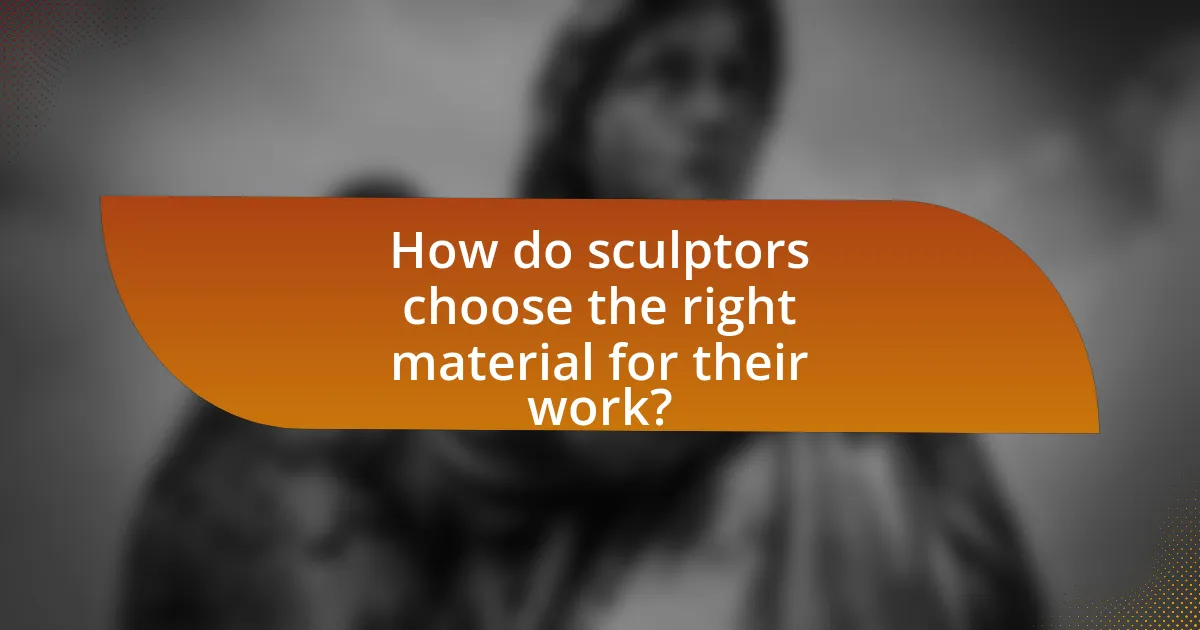
How do sculptors choose the right material for their work?
Sculptors choose the right material for their work based on the desired aesthetic, durability, and the specific techniques they plan to use. For instance, clay is often selected for its malleability, allowing for intricate details, while bronze is favored for its strength and longevity, making it suitable for outdoor sculptures. The choice is also influenced by the intended final form; for example, stone is chosen for its permanence and natural beauty, while wood may be selected for its warmth and organic feel. Additionally, the sculptor’s personal experience and familiarity with a material can significantly impact their decision, as seen in the works of renowned sculptors who often specialize in specific mediums.
What factors influence the selection of materials in wildlife sculpture?
The selection of materials in wildlife sculpture is influenced by factors such as durability, aesthetic qualities, and the intended use of the sculpture. Durability is crucial, as materials like bronze are favored for outdoor sculptures due to their resistance to weathering and corrosion. Aesthetic qualities, including texture and color, also play a significant role; for instance, clay allows for intricate detailing, while stone provides a natural look. Additionally, the intended use, whether for public display or private collection, can dictate material choice, as public sculptures often require more robust materials to withstand environmental conditions.
How does the intended display environment affect material choice?
The intended display environment significantly influences material choice in wildlife sculpture. Sculptors select materials based on factors such as durability, weather resistance, and aesthetic compatibility with the surroundings. For instance, outdoor sculptures often utilize bronze or stone due to their ability to withstand environmental elements, while indoor pieces may be crafted from clay or resin for their intricate detailing and lighter weight. The choice of material is validated by the need for longevity and visual harmony in the specific display context, ensuring that the artwork maintains its integrity and appeal over time.
What is the significance of durability in material selection?
Durability is crucial in material selection for wildlife sculpture as it ensures the longevity and preservation of the artwork in various environmental conditions. Selecting durable materials like bronze or stone allows sculptures to withstand weathering, physical wear, and potential vandalism, thereby maintaining their aesthetic and structural integrity over time. For instance, bronze sculptures can last for centuries, as evidenced by historical artifacts that have survived intact for millennia, demonstrating the effectiveness of durable materials in art preservation.
How do personal style and technique impact material choice?
Personal style and technique significantly influence material choice in wildlife sculpture by dictating the aesthetic and functional requirements of the artwork. For instance, an artist who favors realism may opt for materials like clay or bronze that allow for fine detail and durability, while a sculptor with a more abstract style might choose materials such as wood or stone to emphasize form and texture. The technique employed, whether additive or subtractive, also determines material suitability; for example, additive techniques like modeling are best suited to malleable materials like clay, whereas subtractive techniques like carving require harder materials like stone. This relationship between style, technique, and material choice is evident in the works of renowned sculptors, where specific materials enhance the intended expression and technical execution of their artistic vision.
What materials align best with different sculpting techniques?
Clay aligns best with additive sculpting techniques, while stone is ideal for subtractive methods. Clay, being malleable and easily shaped, allows for detailed work and is commonly used in modeling and casting processes. Stone, on the other hand, requires chiseling and carving, making it suitable for creating durable, long-lasting sculptures. Additionally, metal, particularly bronze, is often used in lost-wax casting, a technique that allows for intricate designs and durability. These materials are chosen based on their properties and the specific techniques employed, ensuring that the final sculpture meets the artist’s vision and functional requirements.
How does an artist’s vision shape their material preferences?
An artist’s vision significantly influences their material preferences by guiding their choice of mediums that best express their conceptual ideas and emotional intentions. For instance, an artist focused on realism may prefer materials like bronze or stone for their durability and ability to capture fine details, while an artist emphasizing abstraction might opt for clay or mixed media to explore texture and form. This alignment between vision and material choice is evident in the works of renowned wildlife sculptors, such as Henry Moore, who utilized bronze to convey strength and permanence, reflecting his artistic intent. Thus, the materials selected by artists are not merely functional but are integral to the realization of their creative vision.
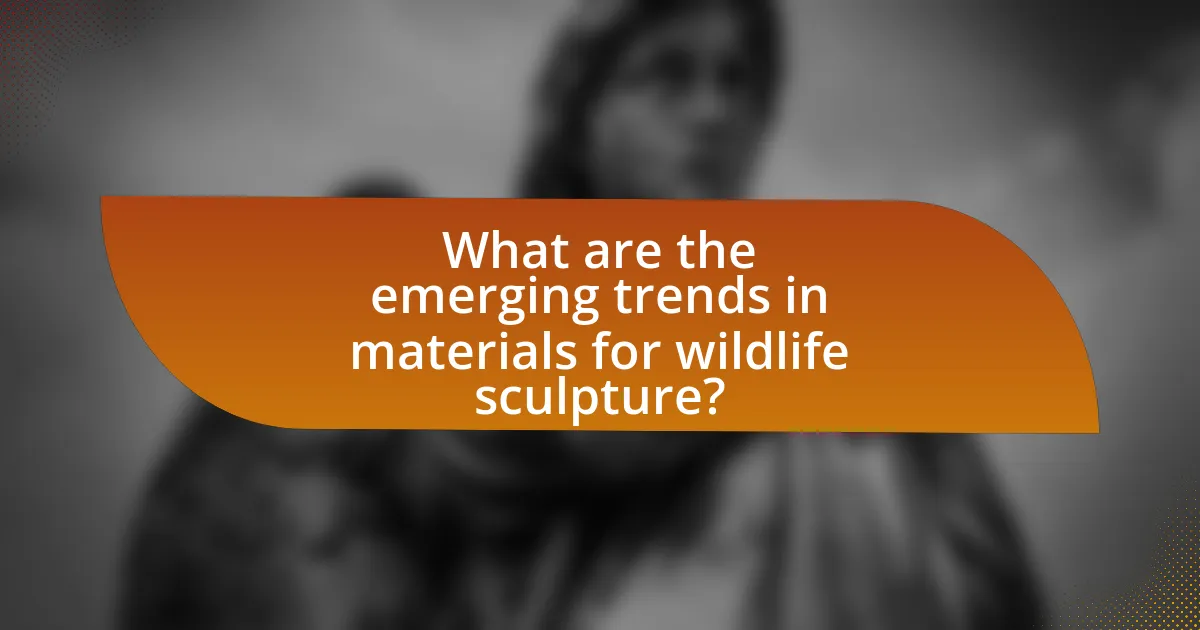
What are the emerging trends in materials for wildlife sculpture?
Emerging trends in materials for wildlife sculpture include the use of sustainable and eco-friendly materials, such as recycled plastics and biodegradable composites. Artists are increasingly prioritizing environmental impact, leading to innovative approaches that reduce waste and carbon footprints. For instance, the adoption of 3D printing technology allows for intricate designs using sustainable materials, enhancing both creativity and sustainability in wildlife art. Additionally, the integration of mixed media, combining traditional materials like bronze with modern elements such as LED lighting, is gaining popularity, providing dynamic visual experiences. These trends reflect a broader movement towards sustainability and innovation in the art world.
How are modern materials being integrated into wildlife sculpture?
Modern materials such as resin, fiberglass, and 3D-printed components are increasingly integrated into wildlife sculpture to enhance durability and detail. Artists utilize these materials for their lightweight properties and versatility, allowing for intricate designs that traditional materials like clay and bronze may not easily achieve. For instance, the use of fiberglass enables larger sculptures to be created without the structural limitations of heavier materials, while 3D printing allows for precise replication of complex textures found in wildlife. This shift reflects a broader trend in contemporary art where innovation in materials expands creative possibilities and accessibility for sculptors.
What innovative materials are sculptors experimenting with today?
Sculptors today are experimenting with innovative materials such as 3D-printed plastics, bio-resins, and reclaimed materials. These materials allow for greater flexibility in design and sustainability in art creation. For instance, 3D printing technology enables artists to create intricate designs that would be difficult to achieve with traditional methods, while bio-resins offer an eco-friendly alternative to conventional plastics. Additionally, the use of reclaimed materials not only promotes recycling but also adds unique textures and histories to sculptures, reflecting contemporary environmental concerns.
How do these new materials enhance the artistic expression?
New materials enhance artistic expression by providing sculptors with greater versatility and innovative techniques. For instance, the introduction of synthetic resins allows for intricate detailing and a wider range of textures that were previously difficult to achieve with traditional materials like clay or bronze. Additionally, advancements in 3D printing technology enable artists to create complex forms and structures that push the boundaries of wildlife sculpture. These materials not only expand the creative possibilities but also facilitate faster production times, allowing artists to experiment and iterate more freely.
What sustainability practices are influencing material choices?
Sustainability practices influencing material choices in wildlife sculpture include the use of recycled materials, sourcing from sustainable suppliers, and adopting eco-friendly production methods. Artists increasingly select materials like reclaimed wood, recycled metals, and biodegradable substances to minimize environmental impact. For instance, the use of recycled bronze not only reduces waste but also lowers energy consumption compared to mining new materials. Additionally, sourcing clay from local suppliers reduces transportation emissions, aligning with sustainable practices. These choices reflect a growing awareness of environmental responsibility within the art community, promoting a shift towards more sustainable artistic expressions.
How are artists sourcing eco-friendly materials for their sculptures?
Artists are sourcing eco-friendly materials for their sculptures by utilizing sustainable resources such as reclaimed wood, recycled metals, and biodegradable materials. Many artists actively seek out local suppliers who provide these materials, reducing transportation emissions and supporting community economies. For instance, a study by the American Craft Council highlights that artists increasingly prioritize materials with lower environmental impact, such as bamboo and natural fibers, which are renewable and have a smaller carbon footprint compared to traditional materials. This shift towards eco-friendly sourcing reflects a growing awareness of environmental issues within the art community.
What impact does sustainability have on the wildlife sculpture industry?
Sustainability significantly influences the wildlife sculpture industry by promoting the use of eco-friendly materials and practices. Artists increasingly prioritize sustainable sourcing of materials, such as recycled metals and responsibly harvested wood, to minimize environmental impact. For instance, a study by the American Craft Council highlights that artists who adopt sustainable practices not only reduce waste but also appeal to a growing market of environmentally conscious consumers. This shift towards sustainability fosters innovation in material selection and encourages the industry to adopt more ethical production methods, ultimately enhancing the overall value and relevance of wildlife sculptures in contemporary art.
What tips can aspiring sculptors follow when selecting materials?
Aspiring sculptors should consider the properties of materials, their intended use, and the final aesthetic when selecting materials for their sculptures. For instance, clay is malleable and ideal for detailed work, while bronze offers durability and a classic finish. Additionally, understanding the drying and curing times of materials like plaster or resin is crucial for planning the sculpting process. The choice of material can significantly impact the sculpture’s longevity and visual appeal, as evidenced by the fact that many renowned wildlife sculptures are created in bronze due to its strength and ability to capture fine details.
How can beginners experiment with different materials effectively?
Beginners can experiment with different materials effectively by starting with small projects that allow for hands-on exploration and gradual skill development. This approach enables them to understand the unique properties and techniques associated with each material, such as the malleability of clay or the durability of bronze. For instance, working with air-dry clay can provide immediate feedback and ease of use, while experimenting with wax can introduce them to the casting process. Engaging in workshops or online tutorials can further enhance their understanding, as these resources often provide structured guidance and practical tips.
What resources are available for learning about material properties?
Resources available for learning about material properties include textbooks, online courses, academic journals, and industry publications. Textbooks such as “Materials Science and Engineering: An Introduction” by William D. Callister provide foundational knowledge on material properties. Online platforms like Coursera and edX offer courses on materials science that cover various properties and applications. Academic journals, including the Journal of Materials Science, publish peer-reviewed research on material properties, ensuring access to the latest findings. Additionally, industry publications like “Materials Today” provide insights into current trends and innovations in material science. These resources collectively offer comprehensive information for understanding material properties relevant to wildlife sculpture and other applications.
